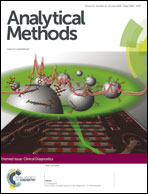Determination of total glutathione in earthworms by ultra-high performance liquid chromatography with fluorescence detection
Abstract
A new, fast and simple methodology for the determination of total glutathione in earthworms, excellent bioindicators of oxidative stress, using ultra-high performance liquid chromatography with fluorescence detection is presented. Total glutathione could be a biomarker of oxidative stress caused by heavy metals such as mercury. The strategy for the analysis was to transform oxidized glutathione (GSSG) into reduced glutathione (GSH) and then to derivatize total GSH with o-pthalaldehyde to a fluorescent adduct. The analysis was carried out using an Eclipse XDB-C18 (50 mm × 4.6 mm × 1.8 μm) column at 25 °C, and using 100 mmol L−1 phosphate buffer at pH 7.0 and acetonitrile (phosphate buffer–acetonitrile, 85 : 15, v/v) as the mobile phase at 1.5 mL min−1. The volume injected was 5 μL and the excitation and emission wavelengths were 340 and 420 nm, respectively. Under the optimized conditions, the retention time of the derivatized analyte was as short as 0.536 min, which allows also a very short time between consecutive injections. The instrumental limits of detection and quantification were 1.8 and 5.3 μg L−1 (5.7 and 17.0 nmol L−1) and the calibration curve was linear up to 5 mg L−1 (16.3 μmol L−1). The methodology was also proved to be robust and precise. The methodology was validated using earthworms spiked with GSH, obtaining recoveries close to 100%.


 Please wait while we load your content...
Please wait while we load your content...